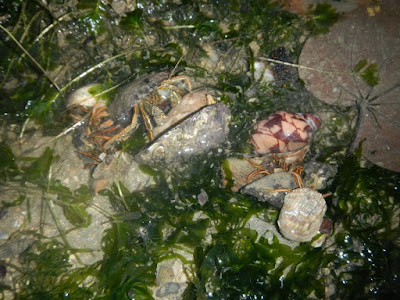I'm back for Day 5 of the Expedition with more field trips, and a 'Pandora' surprise while sorting teeny weeny clams.
As I arrive in the late afternoon, the student volunteers are already leaving after spending the morning there. They'll be back with the Expedition on Monday.
Prof Peter Ng is also going home. Don't be alarmed, he always tries to do a good frown when his photo is being taken. He's actually very happy because he is going home with the special Masked burrowing crab that Chay Hoon found on Day 4 at Changi.
This precious mama crab with eggs will be kept alive. So we can also have a look at her babies when they hatch. This is going to be a rare opportunity to observe this special crab.
The crab was indeed very popular, as this photo shared on the Raffles Museum page shows.
 |
| Shared on the Raffles Museum page |
Prof Daphne shows me a large collection of these big sea anemones that I often see stuck on hermit crab shells on the intertidal. But these anemones came from a dredge! Wow, I didn't know that there were so many of them in deeper water!
More amazingly, Prof Daphne points out how these anemones all turn orange when they are preserved. When alive, they have many different colours and patterns. This is why it is sometimes difficult to tell anemones (and some other marine creatures) apart simply by their colours and patterns. We need to look more closely at them.
There was a little time before the field trips started, so all of us trooped over to do some sorting.
Our job today is super challenging! Apparently, during today's dredge, instead of sand, the sediment comprised mostly super tiny bivalves. Among these were a sprinkling of other kinds of bivalves, tiny snails, itsy bitsy hermit crabs, and tusk shells. Also worms, brittle stars and more. Our job was to sort them out.
Among the strange creatures we sorted out were these plain looking flat bivalves which seem unremarkable. But Dr Tan Koh Siang was very pleased with them as he hasn't seen them in Singapore before. If I recall correctly, he called them 'Pandora'. What a lovely name.
Ivan Kwan is still busy tweeting about the Expedition #MegaMarine, as he has furiously done over the last few days. We will miss him when he leaves for an overseas trip soon. Oh dear. Who will tweet the Expedition now?
Today, I'm heading back to Chek Jawa. We pass by another team hard at work on Pulau Sekudu, which means Frog Island. Here you can see the big rock in the shape of a frog on the island.
Prof Daphne and a small team drop off near the jetty at House No. 1 as we want to survey the mangroves there for sea anemones.
Many people think there are no sea anemones in mangroves, but Prof Daphne proved them wrong! As soon as we arrive, we find the strange spotted sea anemones that she first found in Sungei Buloh.
The rest of the team went to another part of Chek Jawa nearer the beacon. Jonathan Tan shared photos of what they saw, including this frenzy of hermit crabs over a Noble volute shell. Hermit crabs do often 'queue' up for an empty shell in an amusing manner. Here's a similar encounter I had in the past.
They also found a nice jellyfish thingie. Jellyfishes are not well studied so we know little about those found in our waters.
We expect a huge influx of volunteers for the weekend. So I'm going to be there early and stay late. Hope I survive!
Posts by others on Day 5 of the Expedition
- Jonathan Tan on facebook
















